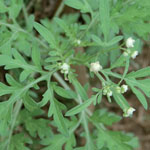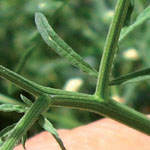Parthenium weed
If you think you may have seen parthenium weed, please contact us by:
- completing this form
- calling our Customer Service Centre on 136 186
- emailing weed.spotters@agriculture.vic.gov.au
Please do not attempt to treat or dispose of this weed yourself. We will treat, remove and dispose of camel thorn safely, at no cost to the land owner.
Why you must report parthenium weed
Parthenium weed originates from parts of North and South America. It was first discovered in Queensland in 1955 and was thought to be introduced via contaminated machinery during World War Two.
It invades disturbed land such as roadsides, stockyards and overgrazed pastures. It has the potential to infest the semi-arid regions of northern Victoria.
Each plant can germinate, grow and set seed within 4 weeks, resulting in multiple germinations in 1 year. One plant can produce up to 20,000 seeds per year.
Parthenium weed:
- produces chemicals which inhibit the growth of other plants
- can cause dermatitis and hay fever in sensitive individuals
- is toxic to cattle.
It currently infests over eight million hectares of Queensland and is also present in NSW and the Northern Territory. It has not been found in Victoria but there is a high risk that it could be introduced.
Identifying parthenium weed
Parthenium weed is an annual or short-lived herb to 2 m tall.
Leaves are grey-green, deeply divided, 5 to 20 cm in length and covered in fine hairs. The leaves are initially in a flat rosette.

Mature stems have distinct grooves along them and are covered in fine hairs.

Flowers are creamy-white, star-shaped and 4 mm across. They are in open branched clusters above the foliage. Flowering can occur all year round in favourable conditions, but usually in summer.

Parthenium weed 3D model
The New South Wales Department of Primary Industries has developed 3D (three-dimensional) models to help people become more familiar with prohibited invasive plants, including parthenium weed, by providing a lifelike representation.
The model can be manipulated and inspected at every angle and magnification and is a great way to become more familiar with parthenium weed.
© Regional NSW through NSW DPI Invasive Species Biosecurity. Model created by Rachel Klyve.
Explore 3D model